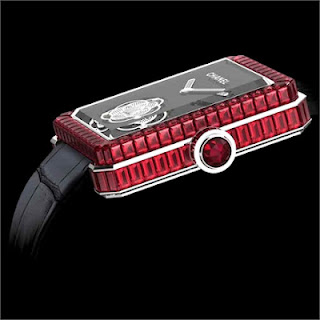
What if I told you to build a mechanical watch which would track unequal hours? Imagine the level of complication the mechanism would require. After all even a Perpetual Calender, which accounts for the differing lengths of months, is a highly complex complication requiring many additional components. So what about a timepiece that tracks uneven time periods.
In the Japanese Edo Period (1603-1868), a variable hour system was used(dating back to the 9th century). The day was divided into 12 segments of unequal length. It seemed almost impossible to track unequal periods of time, but Japanese clock-makers devised a remarkable way to keep time in this way. The history of Japanese advances in mechanical timekeeping is indeed fascinating.
In the 16th century, prior to the "isolation Edo period", where Japan was cut off from the rest of the world, Dutch or European Missionaries traveled to Japan with Western clocks. These clocks, mostly lantern clock in design used the verge and foliate escapement - bars and weights.
In 1603 the Edo Period began - closing Japanese off from the rest of the world and any further European Horlogical advancements such as the invention of the anchor escapement.
Japan cherished perfection and entire families were committed to perfecting a single trade, such as saki producers, silk weavers, marquetry and metal workers. In this period skilled clock maker worked many hours crafting clocks for those who could afford them. Daimyo -powerful territorial lords - commanded over their lands hiring Samurai warriors to keep order and answering only to the shogun. Daimyo, temples, wealthy merchants and possibly highest ranking samurai were the only ones who could afford this clock. Thus the clock became known as the "daimyo clocks". The high price tag ,easily equaling about 20 years of a normal person's wages was due to the specialized craftsmanship and hours of work that went into crafting a daimyo clock. In fact these clocks were so well made, today they are found in much better condition than their Western counterparts from the same time period. The superb craftsmanship may be due to the threat looming over a watchmakers head if he crafted a clock of inferior quality making his Daimyo miss an important engagement. After the clock was completed, it was one person's sole responsibility to maintain it.

Smaller clocks were available in the Edo period, but little is known about them. In addition very few 'Daimyo clocks are found today, since the manner of timekeeping, which I will explain in due course, was seen as a representation of the Edo time period. During the Meiji period this timekeeping system was abolished and hence these clocks were destroyed. The 'daimyo clocks' that survived were actually the ones that were brought out by foreigners.
In the Edo period, the day was divided according to the eastern zodiac into 12 unequal periods represented on the dial of the clock by juunishi-12 zodiac animals
- and Kanji numerals. This system notated daytime divisions rather than fixed periods of hours, minutes and seconds. In Edo Timekeeping sunrise is "the hour of the rabbit" other wise known as "morning six" or the stars fade. Sunset is "the hour of the cock" or "evening six" when the stars appear. Day and night were each divided into 6 segments of approximately two hours each - depending the season and the amount of daylight hours.
 |
| Sake Making in the Edo Period |
Another remarkable difference to Western timekeeping, the numbers allotted to the passage of hours go down.
For example if an individual awoke to six temple bells ringing announcing it is "morning six" ( hour of the rabbit), he would roll up his tatami ready for the day.
He would get to the field, his workbench or the toiling over sake vats at "morning five" (hour of the dragon).
He would work through "morning four"( hour of the snake)
At "morning nine" (hour of the horse), he would break for noon.
Back to toiling at "morning eight" (hour of the sheep), and start heading home at "morning seven" (hour of the monkey)"
The daytime period pertains to two groups of numbers "6,5,4 and 9,8,7.
The end evening hours start at "evening 6" ( hour of the bird)
One may go to sleep at "evening five" (hour of the dog) and sleep through "evening five, four, nine, eight and seven" ( hour of the boar, rat, ox and tiger) waking up to the wind rustling through the sakura trees as clock sounds out six bells announcing the start of a new day.
 |
| Western Clock with Verge and Foliate escapement |
Expert Japanese Watchmakers resolved the issue of variable hour timekeeping by placing grooves on the foliot (horizontal pendulum) and adjusting the weights to after the period of oscillation in order to accelerate or decelerate the clock. In some Daimyo clocks the speed was changed via two balances - one for night and one for day, which could be switched automatically. Another innovation was a movable dial face, whereby the placement of the zodiac characters and corresponding Kanji numerals could be moved according to the season. Another remarkable innovation used pillar clock weights positioned to correspond to different months with each hour of the day. All of these variations required constant manual adjustment, and the resulting timekeeping was lacking in precision. However this timekeeping well suited the Edo period where periods of time varied.
On the 9th day of the 11th month of Meiji 5, "The Imperial Edict on Revising the Calender" ordered the end of the lunar calender and "variable-hour system". Japan was now in the era of modernization in sync with the Western World. 9 years later in Tokyo, Japan, Seiko was founded by Kintarō Hattori.
Sources: "The Spread of Timepieces in the Meiji Period" Uchida Hoshima, Japan Review, 2002, 14: 173-192
Wikipedea: "Verge Escapement"
Wikipedea: " Edo Period"



































